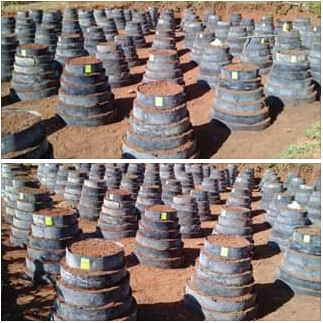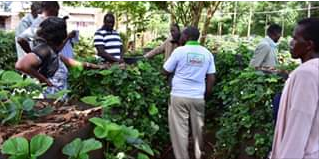
Daniel Gitau Thairu worked for the railway corporation between 1987 and 2002 before leaving to start working on contract for individuals and companies which needed electrical services. During the time (2002-2013), he also ventured into innovations of biogas and bio-digesters where got lured into farming.
“My passion for farming has developed over the years since my departure from the corporation to start working on my own. Each year I have tried to come up with a new innovation to help farmers make their work easier and increase their crop yields,” said Gitau.
In 2013, the agropreneur started Farming Wonder, a farm at Kimunyi, Gatundu Sounth Sub-County in Kiambu County where he began making multi-storey gardens using dam liners to grow fruits and vegetables.
The multi-storey gardens are constructed using dam liner materials with a thickness of 0.5-1mm which are cut into different sizes and fastened using bolts and nuts at the ends to form circular rings with a diameter of 4ft.
RELATED ATICLE: With a multi-storey vegetable garden you can harvest 30kg of kales per bag in your backyard garden every two months
These rings reduces in size by 2 inch upwards to make layers of stakes with a wider base and a narrow top forming a pyramid-shaped structure with terraces.
“I got this idea after noticing that crops planted sideways in sack gardening do not get enough water during irrigation and dam liners have a longer lifespan of over 10 years as they are ultra-heat treated as compared with sacks,” said Gitau.
In total the multi-storey gardens has six layers, each with terraces filled with soil while the top ring holds the top soil. The soil used should be mixed with the less acidic fine goats’ manure on a 50:50 ratio.
According to Gitau, one such structure occupies a space of 4sqft and it can accommodate between 120-130 plants on a six inches spacing depending on the type of vegetable and fruit planted. This is more economical as compared to about 12 plants the same space can accommodate in conventional way.

In addition the multi-storey gardens conserve irrigation water as the staking help minimize evaporation and a farmer can only water crops for up to thrice a week.
“One such garden can take a maximum of 20 litres of water once or twice a week depending on the weather.”
They are also not labour intensive as no major weed control is required and they are applicable both in rural and urban settings.
Today Gitau has 250 multi-storey gardens within his quarter acre farm where he has planted onions, kales, spinach, some indigenous vegetables and strawberries.
“My strawberries are always available all year round with the peak season harvest rising to 50kg per week,” said Gitau.
RELATED ATICLE: Sack farming cuts irrigation water
He has since embarked in training other farmers on this technology offering installation services at Sh2,500 per garden and Sh1,000 coast of training per head in at least three hours.
“We train and offer our services to interested farmers from anywhere in the country as well as attending farmer agricultural events across the country where we find chance to showcase the technology,” said Gitau.
Gitau can be reached on +254 722 427737
















Comments powered by CComment